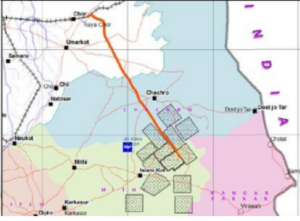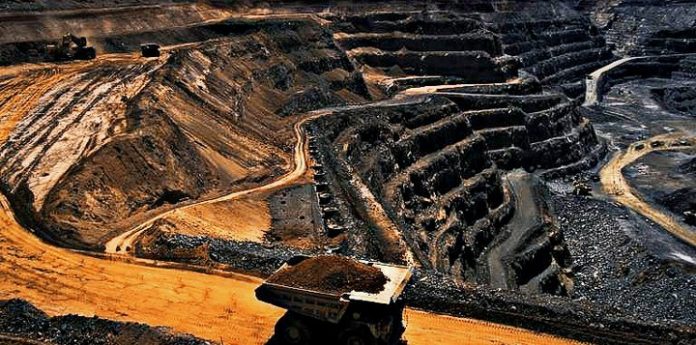The long-awaited project of connecting the Thar coal deposit by railway to the Pakistan Railway network is set to soon receive financing. PC-I of the project has reportedly been prepared and is expected to be approved soon”.
The total project cost of Rs 58.240 billion would be supported on an equal cost sharing basis through the Public Sector Development Programme and the Annual Development Plan.
Background information
Prime Minister Shehbaz Sharif had instructed on October 5th that the Thar Coal Mines be linked to the country’s railway network by March 2023. During a conference presided over by the prime minister, it was determined that the federal and Sindh governments would work together to complete the project of connecting Thar Coal Mines to the rail network.
During the conference he further stated that the connection of Thar Coal Mines to the railway network, local coal would be used in power plants instead of imported coal. This would save $2 billion per year from the power plants that were previously using imported coal.
On March 8, 2019, Special Assistant to the Prime Minister on Power Sector of the previous government convened a meeting of all stakeholders to finalise the modalities for Thar Coal Mines Rail Connectivity Project.
As a result, Pakistan Railways Freight Transport Company (PRFTC) conducted a bankable feasibility study for the Thar Coal Mines Rail connectivity with the National Railways Network from July 2019 to March 2020 on the advice of the Ministry of Railways following rapprochement by Engro Energy Limited through a joint venture of consultants.
The goal of the feasibility study was to examine the overall potential for extending rail links strategically and to make suggestions for project implementation of the most acceptable development option in terms of track alignment, technical standards, financials, and organisation.
The final version of this feasibility study was submitted in May 2020.
It is undeniable that development projects of this nature would be extremely beneficial in the long run. Given the long expected life of the Thar coal mine, development projects around it would yield benefits in the development of labour skills, employment and would facilitate cost effective transportation of Thar coal around the country.
Who will execute the project ?
The company assigned the role of developing this project is the Pakistan Railway Freight Transportation Company (PRFTC)”. The primary objective of this company as the name suggests is to handle the “movement of freight, specially coal by rail from port area at Karachi to up-country”.
The company is granted immense power in terms of planning, designing, operating and managing the operations of freight transportation. The company also has complete authority to procure, own, control and maintain locomotives and rolling stock for the purpose of transporting coal.
PRFTC has further authority to develop as well as maintain its own terminals, maintenance depots, yards, sidings and other ancillary facilities. The government has granted these powers to the company to ensure efficient transportation of freight.
Why is a railway needed?
Rail transportation is critical for any economy as it allows for the shipment of raw commodities over great distances. Apart from coal, railways can facilitate the flow of passengers and other types of freight deeper into Sindh.
Rail has the capacity of no other land transportation option, as train wagons can carry up to 100 tons of freight, more than three times that of a truck. Another essential feature is economies of scale, which means that fixed costs per unit would decrease as volume increased.
Railways are also globally accredited for expediting the industrialization process, as the introduction of rail transportation coincided with an industrial take-off in various countries. It also boosted economic development and population growth.
Currently, internationally imported coal from South Africa, Indonesia, and other nations is being used to meet the needs of Pakistan’s industrial units. Thar coal can easily offset this for not just foreign exchange savings and indigenized fuel mix, but also energy security, local development, community upbringing, infrastructure growth, and equity returns for the government, in addition to paid royalties.
Project details
A transportation system’s fundamental features include universality and simplicity of access. Transportation systems must be designed and arranged for the efficient, convenient, and speedy movement of huge volumes of commodities.
According to the “final feasibility report” for the new train link, four initial options were identified following a complete reconnaissance survey on the ground and information gathered through satellite images and drone studies.
Following a cost-benefit analysis, the route option connecting the mining area with New Chhor in District Umerkot through Bitra and Chachro emerged as the finalised plan for this railway line.
Based upon the feasibility study,this approved routing of the new track is particularly advantageous in that no resettlement or canal irrigated land will be met all along the track.
Additionally this railway alignment provides optimum coverage of all Thar Coal Mine Blocks and far-flung population areas in Tharparkar district while avoiding any existing infrastructural relocations, adding to the value.
The proposed route is roughly 105 kilometres long and connects the Coal Mine area to the Pakistan Railways network near New Chhor station.

Financial costs
The feasibility report calculated the capital cost of infrastructure, rolling stock, and operating and maintenance costs of the project based on preliminary engineering and technical design of the railway system.
According to the summarised costs of the different aspects of the projects, the total cost of construction of the railway track from Thar to Chhor would cost approximately Rs 24.3 billion. Whereas a further capital expenditure on the improvement of the railway track from Chhor to Hyderabad would cost Rs 3.8 billion.
There are several other factors that need to be considered and finalised before a definite cost figure can be calculated. For instance there are two scenarios that have been highlighted in the feasibility study to be considered with regards to train traffic on the railway network.
The Traffic Forecast survey was conducted as part of the feasibility to estimate the amount of coal to be delivered to various consumer destinations in the different parts of the country.
Two scenarios were explored for assessing the project’s traffic forecast.In Scenario 1, the overall quantity of coal to be transported is around 10 million tons per year, but in Scenario 2, the total quantity of coal to be transported is 10.6 million tons per year to consumers in the down country.
Based upon this analysis the exact costs associated with rolling stock would be evaluated. The word “rolling stock” is a broad term used in the railroad business to describe anything with rail wheels. Locomotives, freight cars, flat cars, and other vehicles that employ steel wheels on railroad rails are all included in the definition.
Within this domain the feasibility also presents two alternative options. As for option 1 the purchase of American equipment would be considered, which although is more expensive is considered to be of better quality and have a longer life. Whereas in option 2 Chinese equipment would be purchased.
To summarise impact on capital costs in the various combinations of the total quantity of coal transported and the rolling stock to be used for this purpose are as follows. In the instance of 10 million tons per year to be transported from Thar, using American rolling stock would cost approximately Rs 47 billion and using Chinese equipment would cost Rs 34.6 billion.
In the scenario that 10.6 million tons per year is to be transported to various consumers around Pakistan, going American for rolling stock would cost approximately Rs 26.8 billion and going to the Chinese would cost Rs 19.6 billion.
However another factor that is crucial in arriving at the final decision, is the operating and maintenance cost of said rolling stock. In the case of Chinese equipment the cost is higher as compared to running American machinery, the figure is anywhere between Rs 400-600 million per year.
Transaction structure
The transaction could be set up in a Take or Pay format. This option is based on the premise that the rail project will be built and operated by a Special Purpose Vehicle (SPV). This is a subsidiary established by a parent business to mitigate financial risks. For all intensive purposes it is a company too.
Because the risk is limited to the company, this is one of the safer types of transactions. However, because this Take or Pay model will rely on the capacity payment system, the current tariffs of both NEPRA and Thar Coal Energy Board must be carefully studied in order to determine the returns on such a Take or Pay basis.
For the company, the transaction might alternatively be structured on a Government Guaranteed Revenue Model. In this case, the company will seek an agreement with the relevant government agency under which it will invest in the track structure and recover its investment through capacity fees and variable costs from the power plants.
However, in order for the company to make such a large investment, the company will need a government guarantee, which will include tax exemptions at the operational level as well as general subsidies for a certain time period to allow the company to recover the initial investment cost from tariff payments.
The transaction might also be structured in the form of a rail line concession. This solution is heavily reliant on the company bearing full market risk. The Government of Pakistan, through the Ministry of Railways, can be approached under this paradigm to enter into a concession arrangement.
The MoR has the option of investing in the track structure and entering into a concession agreement with the company. The company would bill the power plants the tariff-determined (or included) coal rate. This tariff rate must include adequate margins to cover both fixed and variable transportation costs.





Good article Assad… thanks for highlighting a very important infrastructure project for Pakistan.
Make your foes into your friends and grab the attention of every eye you cross while you wear this hotter Halloween Leather jacket
We have a massive collection of Halloween Suit Merchandise and Jackets In Very Good Price With Free Shipping!
Oskar Jacket (OJ) aims to fulfill all the fashion requirements of our valued customers under one platform. Our Oskar Jacket (OJ) provides a one-stop solution for all your outfit requirements with free shipping globally. We have a vast range of High-Quality Leather and cotton jackets.
I am a professional leather jackets providers all over the worlds. we have professional Custom Leather Jackets maker for your requirement which you need.
I went this job
I really like the way that you have expressed yourself. There is a lot to be admired from this post. You might want to click on
This is excellent article, thank you for the share! This is what I am looking for, hope in future you will continue sharing such an superb work.
I enjoyed reading this. Thanks for sharing and keep writing. It is good to read blogs like this